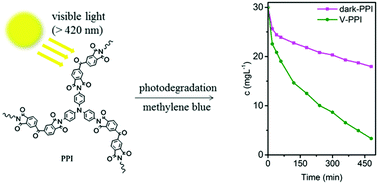4,4′,4′′-Triaminotriphenylamine-based porous polyimide as a visible-light-driven photocatalyst†
Abstract
Aiming to develop a visible-light-driven polymeric photocatalyst that can be fabricated by an easy-to-scale-up polymerization method, a porous polyimide (PPI) with a specific surface area (SBET) of 79.3 m2 g−1 was synthesized by a facile polycondensation of 3,3′,4,4′-benzophenonetetracarboxylic dianhydride (BTDA) with 4,4′,4′′-triaminotriphenylamine (TPA). UV-vis diffused reflection spectroscopy (DRS), electrochemical analysis, valence band X-ray photoelectron spectroscopy (XPS), and density functional theory (DFT) calculation results reveal that the prepared PPI possesses a narrow band gap (2.04 eV) with the valence band (VB) located at 1.26 V (vs. NHE) and the conduction band (CB) edge at −0.78 V (vs. NHE), clearly indicating the visible light activity of PPI. The photocatalytic performance for the degradation of methylene blue (MB) in water was studied, and the results demonstrate that PPI possesses excellent photocatalytic activity under visible light irradiation. Electron paramagnetic resonance (EPR) and photo-current analyses were used to study the photocatalytic mechanism, which show that PPI has a lot of single electron trapped oxygen and more light-generated electrons. This work may provide a cost-effective, potentially scalable strategy to design and develop a polymeric photocatalyst with continuously tunable photoelectrical properties.



 Please wait while we load your content...
Please wait while we load your content...